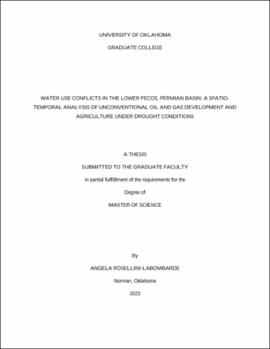| dc.description.abstract | Unconventional oil and gas (UOG) production is increasing rapidly within the U.S., especially the practice of hydraulic fracturing (HF). HF requires large quantities of water, which raises concerns about water scarcity, particularly in arid or semi-arid regions where freshwater is scarce. One of the most productive UOG formations is the Permian Basin, which extends from West Texas into East New Mexico. In this region, the energy sector and the agricultural sector compete for the limited hydrological resources as farmers rely heavily on irrigation using dwindling groundwater supplies or water from the over-allocated Rio Grande River. To make this worse, this area is prone to drought and experienced a megadrought from 2006 to 2015.
This study examines the relationship between UOG production, agriculture, and drought within the Lower Pecos region of the Permian Basin from 2008 to 2021. Previous studies suggest the presence of UOG wells corresponds with an increase in fallow agricultural land, but no such studies have been conducted in a semi-arid region of the U.S. This study uses data from the U.S. Department of Agriculture Cropland Data Layer to identify agricultural areas and their frequency of fallowing agricultural land during the 14-year period. I use point data created from FracFocus data identifying the locations of UOG wells in Texas and New Mexico to examine whether the land immediately surrounding the wells are fallow more often than the land not located near UOG wells. I also use data from the U.S. Drought Monitor to determine if drought impacts this relationship. I hypothesized that agricultural areas immediately surrounding UOG wells will have higher rates of fallowing since water that would normally be used for agriculture is transferred to HF. When under drought conditions, I expected there to be widespread fallowing throughout the study area. The results of this study do not support this hypothesis, and instead found that the fallowing trends throughout the basin do not seem to correspond to either drought conditions or UOG intensity. Overall fallowing trends indicate that until 2018, there were more fallow cells than cropland cells throughout the basin, but the number of fallow cells dropped dramatically in 2017 and after 2018 through 2021, there were more active cropland cells than fallow/idle cropland. UOG intensity increases throughout the basin during the study period, both in the number of wells constructed and the amount of water used per well. This study concludes that while the hypothesis is not supported, there are possibly other factors that impact agricultural and UOG water use. For example, it is possible that farmers switched to less water-intensive crops during drought periods or when new wells were being fractured. It is also possible that HF wells import their water from other sources and are therefore not reliant on available surface or groundwater in the basin. The lack of transparency in UOG wells reporting was the main study limitation. Operators are not required to disclose from the source of the water used. Future research should prioritize verifying UOG wells data by using a combination of sources. This would allow a better understanding of water used across sectors in the Permian Basin. | en_US |
